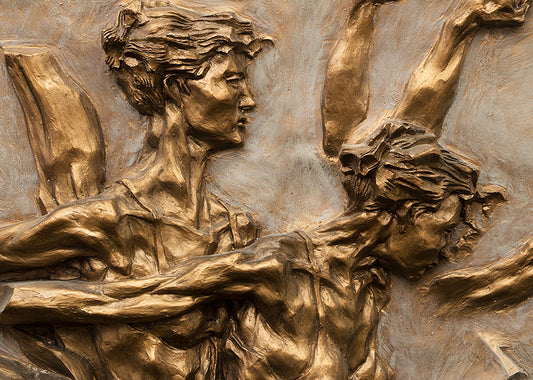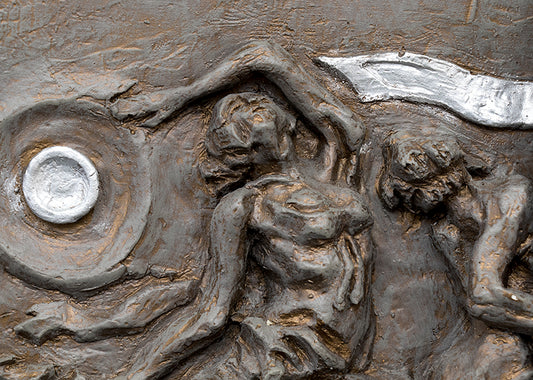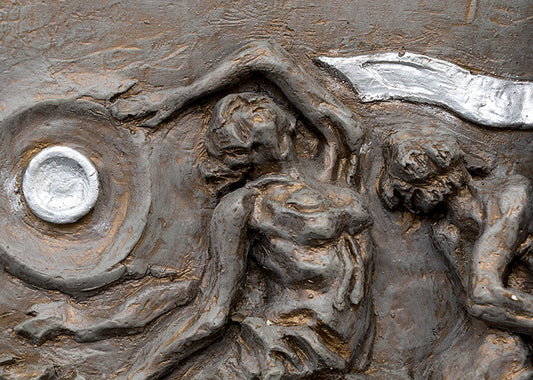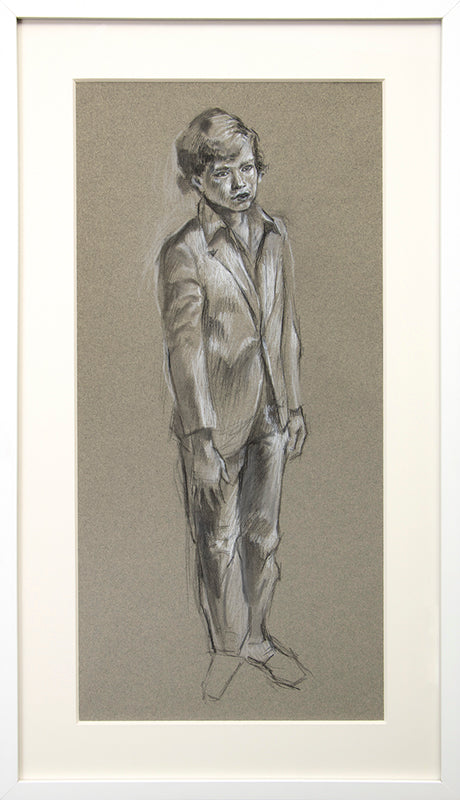Collection: Eric Bransby (1916-2020)
Master muralist, Bransby studied under Thomas Hart Benton, Jean Charlot, Boardman Robinson and more

-
Arabesque (Ballet Dancer in Motion), Sculpture, 1991-2001
Vendor:Eric Bransby (1916-2020)Regular price $6,400.00Regular priceUnit price / per$8,000.00Sale price $6,400.00Sale -
The Cliff (Colorado), Painting, 1997
Vendor:Eric Bransby (1916-2020)Regular price $3,800.00Regular priceUnit price / per -
Rotation (Dancers in Movement), Sculpture, 2014
Vendor:Eric Bransby (1916-2020)Regular price $2,750.00Regular priceUnit price / per -
Rotation (Dancers in Movement), Sculpture, 2014
Vendor:Eric Bransby (1916-2020)Regular price $1,900.00Regular priceUnit price / per -
Pioneer Boy (Study of a Boy), Drawing, 1983
Vendor:Eric Bransby (1916-2020)Regular price $1,100.00Regular priceUnit price / per
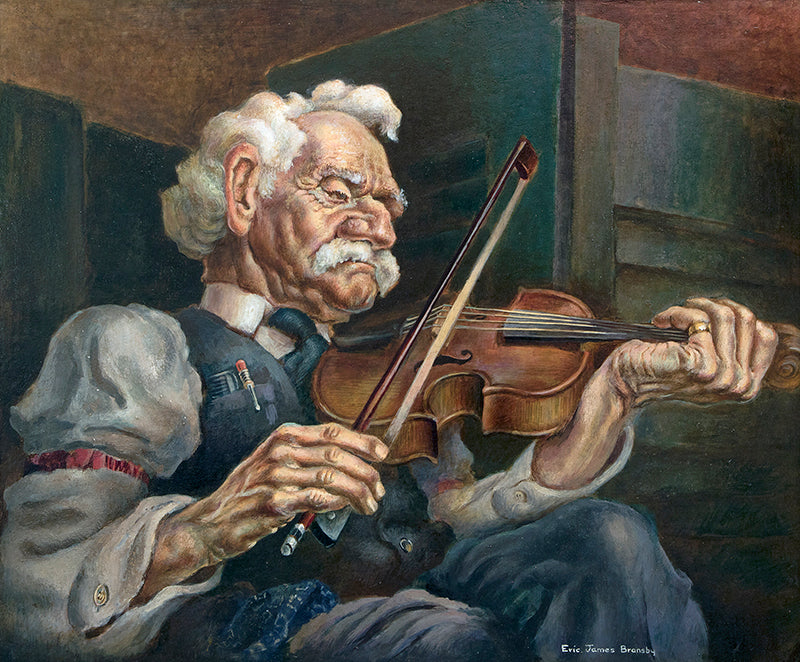
About the Artist
Eric Bransby: A Century (Almost) of Mural Painting
by Henry Adams, November, 2014
Eric Bransby, who is now just two years short of a century old, is a living connection to the great age of American and Mexican mural painting. Bransby studied with Thomas Hart Benton, the figure who initiated the American mural movement of the 1930s, as well as with Jean Charlot, who while not usually given credit for this, was the artist who initiated the Mexican mural movement and its distinctive style--though he was quickly pushed aside by Diego Rivera. Not immune to modern influences as well, Bransby also studied at Yale with Joseph Albers, the famous Bauhaus master. Bransby himself has produced some twenty murals over the course of his career, most of them still extant, including projects for Colorado College, Brigham Young University, Rockhurst College, the University of Missouri, Kansas City, The Sedalia Municipal Building, the City Hall in Liberty, Missouri, the Colorado Springs Fine Arts Center, and the Pioneers Museum in Colorado Springs.
I never had the pleasure of knowing Michelangelo, since I was born 500 years too late, but I have a pretty good understanding of the immense challenges he faced when making the frescoes on the Sistine Ceiling from my friendship with Eric Bransby. When I first got to know him, Bransby was working on a fresco of almost Sistine-ceiling size for the library of Park College, located just outside of Kansas City. Kansas City has enormous natural caves which are located in the limestone cliffs that run along the Missouri River. While many of them are extremely large, it's not hard to make them bigger by chipping away at the limestone a little further; and these caves make a perfect place for storing things, since they are water-proof and relatively constant in humidity and temperature: a perfect place for storing books, for example. Indeed, with these factors in mind, Park College placed its library in one of these limestone caves, creating a space that's not simply practical but also something of a visual marvel--something almost out of science fiction--with wonderful skylights that illuminate the rooms from above, and walls that are sometimes finished, like a normal house, and sometimes rough cave walls, like those enjoyed by our prehistoric ancestors.
Bransby's murals for this space used essentially the same fresco techniques that Michelangelo employed, although with some modern twists, since he supported his fresco panels on steel supports just in front of the wall, so that his frescos can be moved to a new location if it's ever necessary to do so, and so that they can stand free from humidity and drips. Needless to say, the fresco harmonized wonderfully with the "architecture" of this unusual library setting, since it's essentially the same limey substance as the walls of the library/cave. And there's something wonderfully ancient or ageless about the effect, as if the figures were cast shadows from some prehistoric campfire. What's fascinating about fresco, of course, is the peculiar demands of the medium itself, which at once demands spontaneity and careful long-term planning. Once you lay the plaster down you need to work quickly, and finish your painting before it dries. But to get to that stage you need to plan things very carefully. Each section of the fresco needs to fit with the next, almost like pieces of a jig-saw puzzle; as in a theatrical production, whether of actors or marionettes, each figure needs to be ready to take make its entrance and take its position in the right place and at the right moment. A year or so of planning and preparation can easily go into a section that's painted in a few weeks. Even the handling of the pigment, in fact, has an element of abstract planning, since the first application of color is often strangely different from the final effect. Human flesh, for example, is first put down in shrieking hot tones of orange, and then magically transformed into natural-looking flesh tones with a subsequent application of pale cool green. What struck me, in fact, is that mural painting is an art with very distinct properties and requirements that separate it from other branches of painting in rather the way that Indo-European languages have separated from each other, with the result that the fact that you can speak Danish does not mean that you can understand French. Similarly, the fact that you can make an outdoor landscape painting does not mean that you can make a mural or a fresco, since that requires different modes of planning and different pictorial skills. Fresco requires a very particular kind of artist with a particular temperament, and Eric Bransby's career has been almost exclusively dedicated to mastering this very particular art form. There's no clear reason why Bransby took this path. His parents, who were of English background, a minister and a homemaker, had no interest in art, and he grew up in Iowa and Nebraska where he had no exposure to museums. His first serious art project occurred in high school: he attended a puppet show and was so fascinated that just afterwards he became involved in constructing marionettes and a puppet theatre with a friend. At some level, this experience with puppetry was a lasting influence. Years later, Jean Charlot described Bransby as a "bone and joint man," and the figures in his murals have always had something of the look of wooden marionettes, arrayed upon a stage, frozen in mid-performance, populating and penetrating the pictorial space.
In 1938, when he enrolled in the Kansas City Art Institute, Eric Bransby had never heard of Thomas Hart Benton, but it was surely Benton who pushed his talent in the direction of mural painting, and Bransby was one of the select group of Benton's most talented students who showed their work in New York, at Associated American Artists in 1940 - the painting of "The Old Fiddler (Old Chris)" in the current Denver display, is one of the works that was included in that exhibition. Sadly, Benton was fired just before Bransby received his degree from the Art Institute, but Bransby's final project for the school was a mural for Paseo High School, which he created under the supervision of Benton's successor, Fletcher Martin.
Not long afterwards, his interest in mural art was encouraged by two notable figures who taught at the Colorado Springs Fine Arts Center, Boardman Robinson and Jean Charlot. Robinson, who had started his career as a radical cartoonist, was a friend of Thomas Hart Benton, and produced major murals for the Kaufmann Department Store and the Department of Justice in Washington D.C. Sadly, Robinson suffered a stroke soon after Bransby arrived, but something about the gravity of his work, his sense of social mission, became a hallmark of Bransby's work as well. Just a few years ago, Bransby reconstructed a mural Robinson made for the Colorado Springs Fine Arts Center, which had been virtually obliterated by harsh weather and poorly chosen materials.
Jean Charlot, the veteran of the Mexican mural movement, became an intimate friend, and guided him in the creation of a mural on the theme of "Pioneers," that Bransby created for the Cossitt Rotunda on campus. It was a particularly complex project, both because of the curving space of the dome itself, and because it's the central node of several corridors, so viewers experience the mural from different vantage points and different pathways of movement. To think through these issues, Bransby created a three-dimensional model of the dome, and then worked through these issues exactingly, with Charlot's attentive guidance, in a manner strongly influenced by Charlot's compatriot, Jose Clemente Orozco.
A disruptive but stimulating figure in Bransby's evolution was Joseph Albers, with whom he studied in the 1950s at Yale. A committed practitioner of pure abstraction, Albers could be inflexible and dogmatic, but his interest in geometry and abstract effects had a major influence on Bransby's work. Many of his murals employ multiple panels, arranged in free-floating configurations, and his figures are often fragmented to suggest their motion as they turn and point in space. One of the best of these later projects is the mural "Primavera" for the Nichols Library at the University of Missouri-Kansas City, a sort of reworking and "deconstruction" of Botticelli's famous composition in a manner influenced by Cubism and by the motion studies of Eadward Muybridge.
In the Cook Gallery show you can get a good sense of the painstaking craftsmanship that goes into Bransby's murals. For years he's drawn from the model in charcoal or pastel at least a day a week. In these studies he exhaustively studies the bones and sinews of the human body, sometimes creating an almost abstract undulating landscape. His mural studies are almost as striking as the murals themselves, since he draws the figures at full scale. They encourage us to look closely at each section of the mural, as a work of art in its own right, and appreciate the way in which the figures at once coordinate and contest the framing elements of the overall scheme. For anyone interested in mural painting as an art form, this exhibition of Bransby's work provides a rich view into its inner processes from an expert, experienced master - and one who trained and was on intimate terms with many of giant figures of mural-painting in the 20th century.
HONORS - FELLOWSHIPS 1958
- Present Fellow of National Society of Mural Painters 1970 - Present Phi Kappa Phi - National Honorary 2001, 2006 & 2014 Pollock-Krasner Foundation Fellow 2007 Congressional Record Citation - U.S. House of Representatives 1983 Nominated for Triennial Phi Kappa Phi National Award for Artistic Achievement 1977 N.T. Veatch Award for Distinguished Research and Creative Activity 1952 Edwin Austen Abbey Fellowship in Mural Painting
BIOGRAPHICAL CITATIONS AND PUBLICATIONS
1968 A Show of Color - Colorado Springs Fine Art Center (catalog) 1973 Art in Architecture Sourcebook - Housing and Urban Development international competition 1975-2001 Who's Who in American Art - Marquis Publications Board 1981 Brolin & Richards Sourcebook of Exterior Architectural Ornament - Yan Nostrand Reinhold 1989 Pikes Peak Vision: The Broadmoor Academy - Colorado Springs Fine Arts Center (catalog) 1992 Under the Influence: The Students of Thomas Hart Benton - Albrecht-Kemper Museum (catalog) 2001 From Roots to Soaring Vision - Colorado Springs Fine Arts Center (2 person retrospective catalog)
SELECTED EXHIBITIONS United States & Europe
- New York Architectural League - National Society of Mural Painters - Moscow, Russia - National Society of Mural Painters - National Collection of Fine Arts (Smithsonian - two year traveling exhibit) - Library of Congress, Washington, DC (Print Annual and permanent collection) - Joslyn Memorial, Omaha, Nebraska (6 States Annual; Biennial) - Oakland Galleries, Oakland, California - Denver Art Museum, Denver, Colorado (Denver Annual) - Dallas Museum, Dallas, Texas (Print Annual; Drawing Annual) - National Center for Fine Arts, Washinton, DC (murals) - National Society of Mural Painters (Touring Exhibition, 1979-1984) - West Surrey College, Surrey, England - New York Art Students League - National Society of Mural Painters - Pikes Peak Center, Colorado Springs, Colorado (Fifty Year Retrospective) - Retrospective Exhibit - Taylor Museum, Colorado Springs Fine Arts Center, Colorado Springs, Colorado - Retrospective Exhibit - Indian State University - Retrospective Exhibit - University of Georgia PUBLIC COLLECTIONS - Nelson-Atkins Museum of Art - Kansas City, Missouri - Colorado Springs Fine Arts Center - Colorado Springs, Colorado - Georgia Museum of Art , University of Georgia - Athens, Georgia - Brigham Young University Museum of Art - Provo, Utah - Kirkland Museum of Fine & Decorative Art - Denver, Colorado - Print Research Foundation - New York - Princeton Print Club - Princeton, New Jersey

